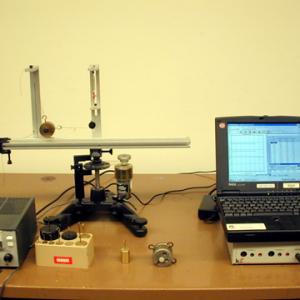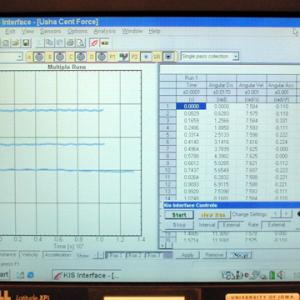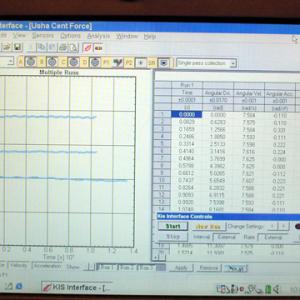College of Liberal Arts & Sciences
1D50.52 - Central Forces - Centripetal Force - 1 to 4 mass ratio
Video Credit: Jonathan M. Sullivan-Wood
The masses that have the 1 to 4 ratio are the brass mass at 105 grams and the steel mass at 420 grams. Put the 105 gram mass on the Pasco apparatus and show that a 100 grams weight can make the mass hang straight down in line with the indicator on the unit. Now rotate the unit until you find the rotation rate that makes the mass again hang straight down according to the indicator. This rotation rate can be recorded with the interface. Now do the same operations with the 420 gram mass and again record the rotation rate with the interface. These two plots can be displayed simultaneously to show that the rotation rates are in a ratio of 1 to 2.
The brass mass has attachments that can take it to 210 grams, or double it's starting mass. This gives your an intermediate mass and rotation rate if you want to plot the curve.
- Alzira Stein-Barana, Deisy P. Munhoz, Douglas A. Galbiatti, Cristiane S. Leme, "Uniform Circular Motion: Playing with Mini Wind-Up Trains", TPT, Vol. 48, # 7, p. 487.
Disclaimer: These demonstrations are provided only for illustrative use by persons affiliated with The University of Iowa and only under the direction of a trained instructor or physicist. The University of Iowa is not responsible for demonstrations performed by those using their own equipment or who choose to use this reference material for their own purpose. The demonstrations included here are within the public domain and can be found in materials contained in libraries, bookstores, and through electronic sources. Performing all or any portion of any of these demonstrations, with or without revisions not depicted here entails inherent risks. These risks include, without limitation, bodily injury (and possibly death), including risks to health that may be temporary or permanent and that may exacerbate a pre-existing medical condition; and property loss or damage. Anyone performing any part of these demonstrations, even with revisions, knowingly and voluntarily assumes all risks associated with them.


